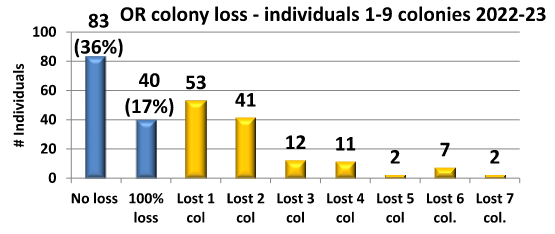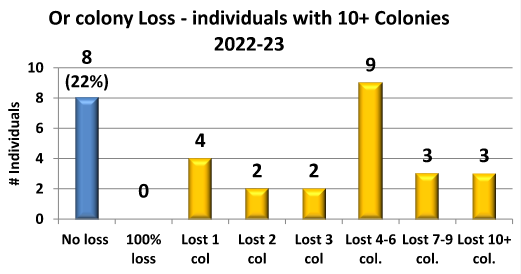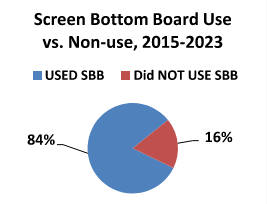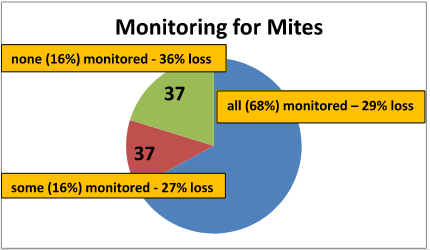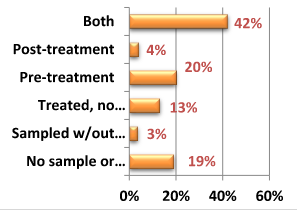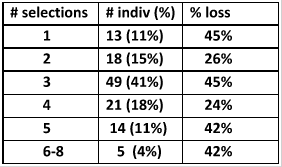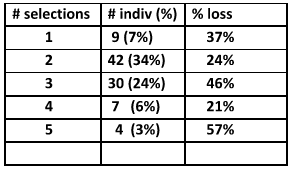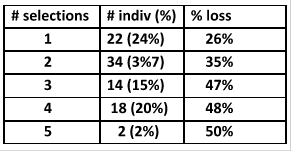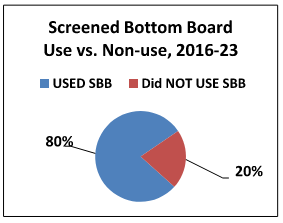** Looking for a report in your specific region? Refer to the Individual Club Reports page.
** Scroll down to see the Washington Backyard Beekeepers Winter Bee Loss Report, 2022-23 or click here to view Washington as PDF.
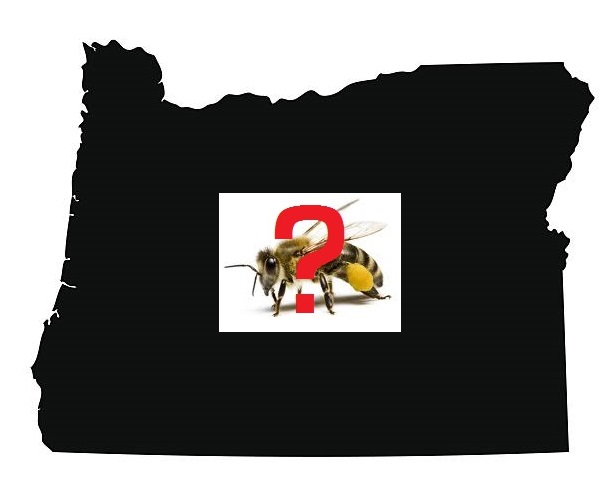
Winter Bee Losses of Oregon Backyard Beekeepers for 2022-2023
by Dewey M. Caron
Click here to view a PDF of Oregon report.
Overwintering losses of small-scale Oregon backyard beekeepers increased slightly to 30% this winter two percentage points higher than last year. This report presents the results of our 14th season of Oregon hobbyist/backyard beekeeper surveys. This annual survey: www.pnwhoneybeesurvey.com. Herein we discuss the data provided by 233 Oregon beekeepers, 10 fewer than last year. Results of the 120 Washington respondents completing surveys (increase of 40 over last year) are included in a separate loss report. Washington’s average loss was 36%.
2022 -23 State/Club Losses
Club results of 12 local Oregon associations and both Oregon and Washington state-wide (+ “other” category for Oregon) are shown in Figure 1. Colony numbers ranged from 1 to 48 colonies in Oregon (average 5.7 colonies slightly higher ( 0.26) than last year; medium number = 4 colonies, one more than last year) and 1 to 38 in Washington (Average 5.8 down 0.4 percentage point from last year; Median number = 4 up one from last year). The number of respondent individuals is listed next to the association name. The bar length is the average club loss percentage for the year.
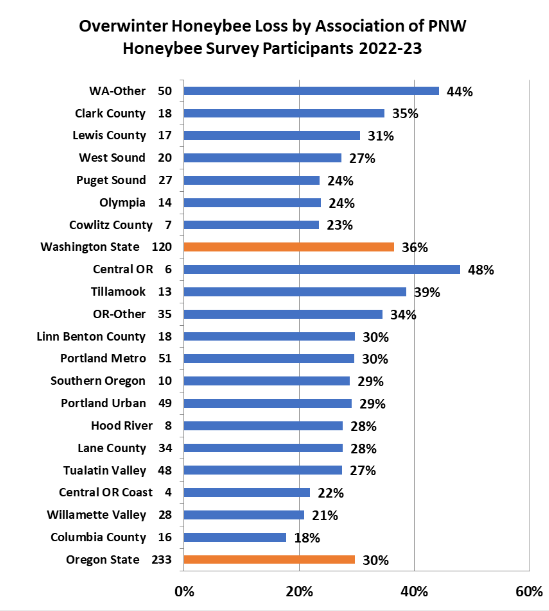
Overwinter losses of members of different organizations varied from a low of 18% for the 16 Columbia County beekeeper respondents to a high of 48% for the 6 central Oregon Association. The 3X range of losses was the same as last year but less than the previous year (4X difference). The difference between the two states – 30 percentage point average loss in Oregon (233 respondents) versus 36% average loss for 120 respondents in Washington has occurred most years – last year it was a seven percentage point difference . The 35 “OR-other” includes respondents from Central and South Coastal, Coos Co, Klamath Basin, Douglas Co and Southern Oregon. Approximately 86% of respondents are roughly along the I-5 corridor between California and Washington.
2022-2023 Overwinter Losses by Hive Type
The loss statistic was developed by asking the number of fall colonies and surviving number in the spring by hive type. Respondents had 1,333 fall hives (within 10 of the respondent number last year) of which 937 survived to spring (396 lost), equating to a 30% loss (70% survival rate). This was a two percentage point greater loss over the previous winter loss rate. Ninety-one percent of hives were 8-frame or 10-frame Langstroth hives or (21) long hives which had an overall survival rate of 29%. There were 64 fall nucs (30% loss rate). Among non-traditional hive types were 28 top bar hives (39% loss) and 10 Warré hives (40% loss). Other hive types included Layens, log, Apimaye, pagoda and Slovenian and 11 not identified.
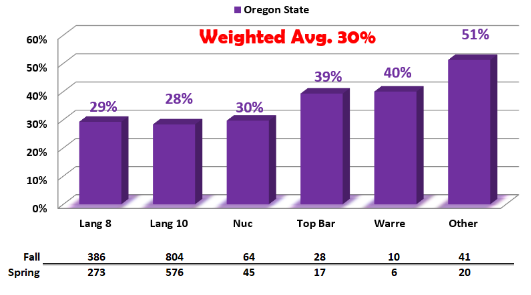
The winter losses of PNW 8-frame Langstroth hives was a single percentage point greater compared to the loss rate of 10-frame Langstroth hives. The loss rates of Langstroth 8 and 10 frame hives over the past 8 years has averaged 36% for 8 frame Langstroth hives and 40% loss for 10 frame hives respectively. Nuc losses are typically higher than losses of 8 or 10 frame Langstroth hives, this year only a single percentage point greater. The Nuc 9-year average loss is 45%. This year’s Top Bar hive loss of 11 colonies (39%) is below the 9-year average top bar hive loss of 52%. The 2023 Warré hive loss rate of 40% is close to the 8-year average of 42.6%.
2022-2023 Loses Based on Hive Origination
We also asked survey respondents to characterize their loss by hive origination. The result is graphically presented below. Overwintered colonies obviously had the best survival (20%) with the 199 splits/divides and 11 feral transfers also with excellent survival. Packages (60%) and nucs (51%) were higher with package bee survivals exhibiting triple the loss rate of the overwintered colonies. The origination loss percentages are relatively the same each year.
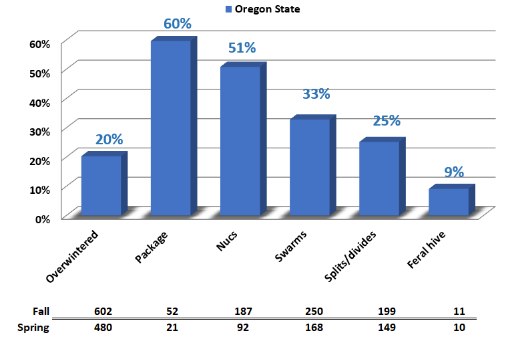
2022 -23 Individual Hive Losses
Thirty-five and a half percent (83 individuals) of Oregon respondents had NO LOSS overwinter, whereas half that number, 17% (40 individuals) lost 100% of fall colonies. Figure 4 below shows loss of individuals with 1 to 9 colonies and figure 5 shows loss of 9.5% (22 individuals) individuals with 10+ colonies. The loss of a single colony (by 57 individuals) represents 38% of total individuals reporting loss. Eight individuals (5.5%) lost 7 or more colonies.
The highest loss by a single beekeeper was 14 colonies. Loss numbers are reflective of the fact that the median number of bee colonies of backyarders was 4 colonies. Of 396 colonies lost in Oregon, individuals with 1, 2 or 3 colonies lost 114 colonies, 29% of total; overall individuals with 1-9 colonies lost 36.5% of their colonies while individuals with 10+ colony numbers lost ½ that level – 21% of their colonies.
Individuals who had 10 to 48 colonies lost 124 total colonies. These individuals lost anywhere from 1 to 14 colonies; 8 individuals with 10 or more colonies lost no colonies. This group lost a smaller percentage of colonies (21%) than the overall statewide group (30%) and the individuals with 1-3 colonies (36.5% loss average).
Survey respondents are primarily small colony number beekeepers – 47% had 1-3 colonies but they vary considerably in their years of beekeeping experience. Looking at losses by colony holding numbers, the 110 individuals who had 1-3 colonies had 41% loss level, the 57 individuals with 4-6 fall colonies (24.5% of individuals) had a 39% loss level, the 30 individuals with 7-9 fall colonies (13% of individuals) had a 29% loss level and the 36 individuals with 10+ colonies (15.5% of respondents) lost 21% of their colonies. Numbers are close to those of last year.
By years of experience, the 79 individuals who had 1 to 3 years bee experience (34% of total respondents) had 37% colony loss level, the 65 individuals with 4-6 years experience (28% of survey takers) had a 26% loss level, the 37 individuals with 7-9 years experience (16% of respondents) had a 30% loss level and those 52 individuals (22% of respondents) with 10+ years experience had a 27% loss level. This is shown graphically in Figure 6. The arrows show that as colony numbers or years experience increase the percent loss level decreases.
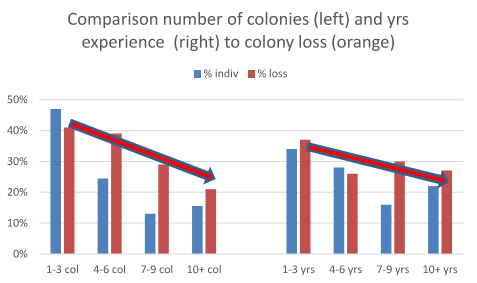
Overwinter Losses the Past 14 Seasons
The losses of the past 14 years are graphed in Figure 7. Despite the lower losses the past 2 seasons, the average loss by Oregon beekeepers is 37.5%. Red dashed line is the trend line. This average loss has changed little in the past 14 years, although seasons with heavier losses have occurred.
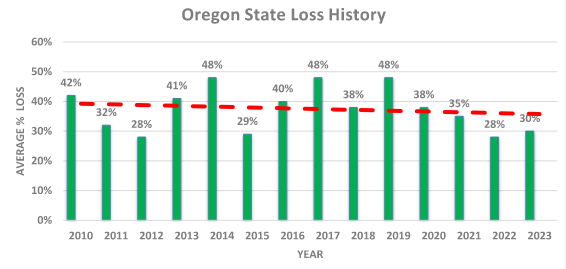
Comparison of the annual losses of backyarders with commercials is shown in Figure 8. The commercial losses are obtained from a different paper survey distributed by Oregon State University. Seven Oregon commercial and semi-commercial beekeepers, three fewer than last year with 25,855 fall colonies, (approximately 29% of the estimated total number of colonies in the state) reported overwinter losses of 29%. Small scale (backyard) beekeeper losses have ranged from six to 20 percentage points greater compared to losses of commercial/semi-commercial beekeepers over the last 14 years as shown below but were essentially equal this year. Fourteen-year average Backyard losses =37.5% loss and 14-year commercial/semi-commercial loss = 21%. The dashed lines are a loss trend.
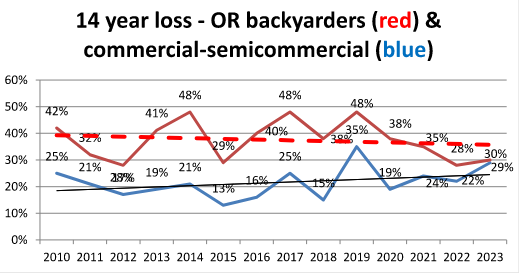
Some Other Numbers
Thirty-five individuals (15%) had more than a single apiary location. The loss level at 2nd apiary was only one percentage point poorer but the individuals who had a 3rd apiary had double the loss level. Seventy-four percent (74%) of respondents (2.5% below last year) said they had a mentor available as they were learning beekeeping. Nine percent (9%) had more than one hive type. And, finally, 18 individuals (8%) moved their bees. One was forced to move, one moved because other colonies were being robbed, one moved nucs and two indicated they moved for better honey production. Four moved for pollination and another two moved to a wintering yard at the end of season. Distances were within the same property up to miles away (for relocation and pollination).
Perceived Colony Death Reason and Acceptable Level
The survey asked individuals that had colony loss (83 individuals had no loss) to estimate what the reason might have been for their loss (multiple responses were permitted). There were 262 total listings, 1.7/individual. Varroa (67 individuals followed by Weak in the fall (45 choose) and queens, 44 individuals, were most common. Poor wintering (27 individuals), Starvation, 20 selections and yellow jackets respondent choices were next most common. 15 individuals didn’t know. Among other 3 indicated extreme cold and rain, 3 excessive swarming or absconding. One individual said small hive beetle, 1 said covers left ajar, another said ants and 1 said late treatment while one other said the mite treatment itself.
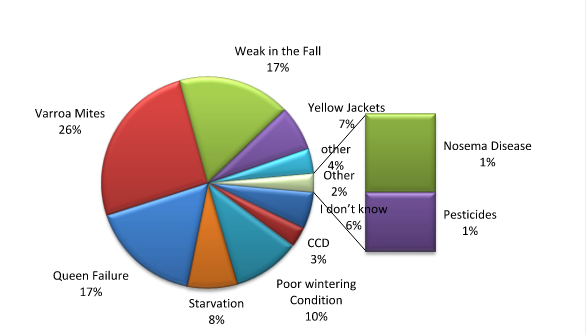
Acceptable loss: Survey respondents were asked the reason for loss. Thirty-one (13%) indicated zero (no loss). Forty-two percent of individuals indicated 15% or less; 20% was medium choice, as has been the case for several years. The most common response was 25%. Twelve percent said 50% or greater was an acceptable loss level; two each said 75 and 100% loss levels acceptable. See table below.

Why colonies die?
There is no easy way to verify reason(s) for colony loss. Colonies in the same apiary may die for several reasons. Examination of dead colonies is at best confusing and, although some options may be ruled out, we are often left with two or more possible reasons for losses. A dead colony necropsy can be of use. Opinions vary as to what might be an acceptable loss level. We are dealing with living animals which are constantly exposed to many different challenges, both in the natural environment and the beekeeper’s apiary. Individual choices varied from zero to 100%, with a medium of 20%.
Major factors in colony loss are thought to be mites and their enhancement of viruses especially DWV (deformed wing virus), VDV (Varroa destructor Virus (also termed DWV B) and chronic paralysis virus. But we do not have a test for these viruses; 2 individuals indicated viruses as possible reason for loss. It was interesting in that varroa and queen problems were nearly equally indicated as were weak in the fall; poor wintering and starvation were other estimated reasons for loss.
Declining nutritional adequacy/forage and diseases, especially at certain apiary sites, are additional factors resulting in poor bee health. Yellow jacket predation is a constant danger to weaker fall colonies. Management, especially learning proper bee care in the first years of beekeeping, remains a factor in losses. What affects our changing environment such as global warming, contrails, electromagnetic forces, including human disruption of them, human alteration to the bee’s natural environment and other factors that play in colony losses are not at all clear.
There is no simple answer to explain the levels of current losses nor is it possible to demonstrate that they are necessarily excessive for all the issues our honey bees face in the environment. It was encouraging to see from survey responses that losses this past year 30% were still at a low level. More attention to colony strength and possibility of mitigating winter starvation will help reduce some of the losses. Effectively controlling varroa mites will help reduce losses.
Colony Managements
We asked in the survey for information about some managements practiced by respondents. The survey inquired about feeding practices, wintering preparations, sanitation measures utilized, screen bottom board usage, mite monitoring, both non-chemical and chemical mite control techniques and queens. Respondents could select multiple options and there was always a none and other selection possible. This analysis seeks to compare responses of this past season to previous survey years.
Most Oregon beekeepers do not perform just one management to their colony (ies) toward improving colony health and overwintering success. This analysis however is mainly of a single factor equated with the loss level of those same individuals. Such analysis is correlative – doing a similar management as fellow beekeepers does not necessarily mean you too will improve success.
FEEDING: Oregon survey respondents checked 620 feeding options = 3.1/individual. Thirty -three individuals (15%), other than those who indicated no feeding, selected a single choice and had 33% loss, 60 (27% of respondents) indicated 2 choices (31%, loss), 74 (34%the greatest number and medium) indicted 3 choices (they had 26% loss), 39 individuals (20%) had 4 choices with 36% loss, 17 (8%) had 5 choices (24% loss), 8 individuals had 6 choices with 21% loss. And 1 had 7 and 1 had 8 choices with a 13% loss. The choices, with the number of individuals making that selection is in ( ) in Figure 10; bar length indicates loss level of individuals doing this management. Those bar lengths to the
left of 30% green dashed marker had better survival while those to the right had greater loss level. Eleven individuals (same number as the previous year) said they did NO FEEDING. They had 55 fall colonies, lost 19 for a 35% loss. For individuals indicating one or more feeding managements, feeding sugar syrup was the most common feeding option of respondents (189 individuals, 86% of respondents who indicated feeding management). Their loss rate was 28.5%, essentially the same as the overall average. Individuals feeding protein had an overall better survival rate , with the pollen patty feeders (141 individuals, 64% of total respondents) showing a 3 per cent improvement over average loss. The non-liquid sugar feeders likewise had a 3 percent improvement over average, mainly due to the 64 hard candy and 64 dry sugar feeders, 58% of total respondents.
Summary: Statewide for the last 7 years individuals doing no feeding had 6 percentage point higher losses (average 45%) i.e. poorer survival, compared to an average loss rate of 38%. The average percent doing no feeding = 7% of individuals – this year it was 5.7%). Individuals statewide that fed sugar syrup had a 4.3 percentage point lower loss level average for the 7 years; this year it was one percentage point greater survival. Those feeding honey (as frames or liquid) had lower loss only during 3 of the past 7 years, this year it was a one point improvement. Individuals feeding non–liquid sugar (in any of the forms) had lower losses six of past 7 past winter seasons; this year it was a 3 percentage point difference, same as last year. Dry sugar feeders had slightly better or equal survival all 7 past winters while hard candy feeders had a much-improved survival 6 of 7 past winters, including this past winter. Fondant feeders had better survival 3 of the 7 past winters, but not this season.
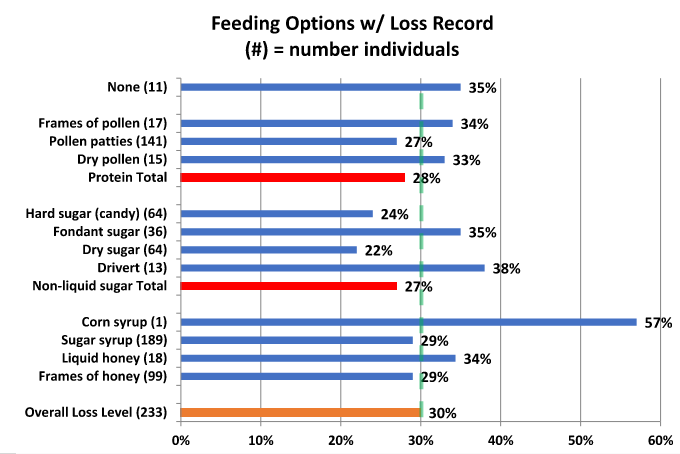
For individuals feeding protein, the protein patty users showed better survival 6 of 7 years (this year losses were 2 percentage points better; dry pollen feeders had better survival in three of the past seven years. Pollen patty feeders had the best survival this year.
WINTERING PRACTICES: We received 552 responses (2.57/individual) about OR beekeeper wintering management practices (more than one option could be chosen). Eighteen individuals (8%) of the respondents indicated doing none of the several listed wintering practices; these individuals had an elevated 40% winter loss, 10 percentage points higher than overall loss. For those indicating some managements, 40 (19%) did one single thing, (21.5% loss), 59 did 2 (39% loss), 43 (median number) did three (17% loss), 25 did 4 (50% loss), 8 did 5 (36% loss) and 1 did 6 with 67% loss. Doing more did not ensure overwintering success
The most common wintering management selected was ventilation/use of a quilt box at colony top (128 individuals (59%), same percentage compared to previous year) followed by insulated top (118 individuals, 52% of respondents an increase of 2 percentage points from the previous year). The Vivaldi board had 2 percentage point poorer survival while those using the insulated top had 4 percentage point better survival. Figure 11 shows percent of individual choices and bar length shows percent winter loss of each selection. Bars to the left of the green dashed line means better survival than overall. Only equalizing (along with insulted top) improved winter survival.
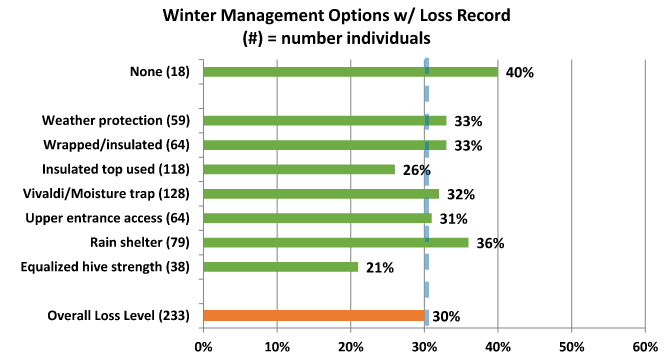
Over the past six years individuals that did no winterizing practice (average 11.3% of individuals) averaged 41.3 loss compared to 37.7% overall average loss of the last 6 years, a 4.6 percentage point poorer survival rate. Only a single winterizing management improved survival all 6 years – insulated top (6 year average loss of 30%, a 7.7-percentage point improvement). Vivaldi/quilt box, upper entrance (most Vivaldi boards have an upper entrance built into the equipment), wrapping and wind/weather protection had only slightly improved survival rates and were not noted in all past 6 years. Equalizing hive strength was the best management to improve survival both this and the past year.
SANITATION PRACTICES: It is critical that we practice some basic bee sanitation (some prefer use of term bee biosecurity) in our bee care to help insure healthy bees. We received 483 responses for this survey question 2.4/individual. Thirty individuals said they did not use any of the 6 offered alternatives; they had a loss rate of 30% compared to the overall rate also 30%. Over the past four-years those indicating doing none had a 42.9% percent loss rate, 5.5 percentage points higher than the average loss rate of 37.4% over the same time period. Ninety-five (47 %) individuals had 1 selection with 29% loss, 69 (34%) had 2 choices (the median number) with 32% loss level, 36 selected 3 managements (25% loss level), 25 had 4 (37% loss level), 7 had 5 selections with 30% loss level and one individual with 5 colonies had 5 selections and didn’t lose any colonies. Minimal hive intervention (98 individuals) was the most common option selected, as it has been for the last 4 years. It could be argued that less intervention might mean reduced opportunity to compromise bee sanitation efforts of the bees themselves and that excessive inspections/ manipulations can potentially interfere with what the bees are doing to stay healthy. This option, however, did not demonstrate improved winter survival; the loss rate for this group the past 6 years was 47%, eleven percentage points above the average 6-year loss of 36% loss rate compared to those individuals that did nothing.
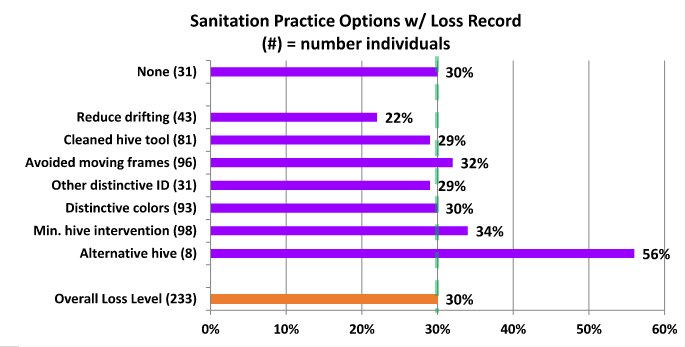
Avoiding moving frames and reducing drifting were the two sanitation choices that demonstrated better average survival the past six years – 6-year loss rate was 34.3% for not moving frames which is 1.7 percentage points better survival (this and last year it was 2 percentage points higher than average) and 30.5% for reducing drifting a 5.5 percentage point improvement in survival, the best management for reducing loss this year. Overall sanitation appears to be relatively minor toward improving survival.
SCREEN BOTTOM BOARDS (SBB)
Although many beekeepers use SBB to control varroa, BIP and PNW surveys clearly point out they are not a highly effective varroa mite control tool. In this recent survey, statewide 19 individuals (8%) said they did not use screen bottom boards. This is the lowest percentage of the last 3 years for non-use of a screened bottom – 25% said they used it sometimes. Average non-use for the last eight years is 16%, vs 84% use, on some or all colonies.
This past overwintering season, the 38 non-SBB users had winter losses of 27 colonies, a 28.5% loss. Examining the eight-year average of SBB use, loss level of the 84% using SBB on all or some of their colonies had a 33.9% loss level whereas the 16% not using SBB had loss rate of 36.8%, a 3.1-percentage point positive survival gain for those using SBB versus those not using them. Screen bottom boards offer a minor improvement for overwinter survival.
We asked if the SBB was left open (always response) or blocked during winter. This past season, 67%, 150 individuals, said they always blocked SBB during winter; 22 individuals statewide said they blocked some of the SBBs. Statewide those who blocked always or sometimes had 999 colonies in the fall and lost 717, a 28.2% loss rate. Those 51 who never blocked had a 28.5% winter loss, a mere 0.3-percentage point difference. As in past years, there was a slight advantage in favor of closing the SBB over the winter period to improve survival.
Screen bottom board use has a slight survival advantage. For those using SBB, the advantage appears to be to close, partially or completely, the screen over the winter period.
Things that seem to improve winter success: It should be emphasized that these comparisons are correlations not causation. They are single comparisons of one item with loss numbers. Individual beekeepers do not do only one management, nor do they necessarily do the same thing to all the colonies in their care. We do know the inability of bees to manage moisture overwinter kills bees, so we recommend hives be located in the sun out of the wind. If colonies are in an exposed site, providing some extra wind/weather protection and wrapping/insulating colonies might improve survival.
Feeding, a basic management for all livestock, appears to be of some help statewide in reducing losses. Feeding a hard sugar candy or dry sugar during the winter means lower loss levels. Providing frames of honey and feeding sugar syrup also yields lower losses for some individuals. Such feeding management is of great value for spring development and/or development of new/weaker colonies as well as for colony rearing of bees to overwinter. Feeding protein in any form did slightly improve survival. The supplemental feeding of protein (pollen patties) might additionally be of assistance earlier in the season to build strong colonies and in the fall to build the fat bee population needed for successful overwintering. To determine if feeding might help monitor what sources your bees are visiting and manage accordingly.
Winterizing measures that apparently helped lower losses for some statewide beekeepers were top insulation and wrapping the colonies (or otherwise adding some insulation to provide added protection against the elements). Spreading colonies out in the apiary and doing other measures to reduce drifting also appeared to be of some value in reducing winter losses. Avoiding movement of frames from one colony to another might also improve survival but the gain over what this interchange might accomplish to bolster weak colonies and start new divides might be greater than a minor advantage in survival.
Replacing standard bottom boards for screened bottoms marginally improved winter survival. It is apparently advantageous to close the bottom screens during winter. It is clear that doing no feeding, winterizing or sanitation resulted in the heaviest overwinter losses.
Mite monitoring/Sampling and Control Management
We asked the percentage of Oregon hives monitored for mites during the 2022 year and/or overwinter 2022-23, whether sampling was pre- or post-treatment or both and, of the 5 possible mite sampling methods, what method was used and when it was employed. 159 individual respondents (68%), two percentage points above the previous year, said they monitored all their hives. The losses of those individuals monitoring was 29%. Thirty seven individuals (16%) reported no monitoring; they had a higher loss rate of 43% loss. 37 individuals reported monitoring some of their colonies; they had a 23.6% loss.

Monitoring alone is a means towards improved winter survival. The table below compares % individuals and % winter loss for individuals who monitored all colonies compared with those who monitored none. Seven-year difference is 8 percentage point better survival monitoring all colonies. The loss rate of 13-15% who monitored some colonies was variable, averaging 4 percentage points lower than those monitoring all colonies.
Individuals indicated use of 1.85 monitoring techniques on average. In total choices, in order of popularity of use, 104 individuals used alcohol wash and 98 individuals used Sticky boards (53 and 50% respectively of those responding to using a monitoring technique. 48 individuals used powdered sugar monitoring; visual inspection of drones (53 individuals) and visual inspection of adults (60 individuals) were also indicated. In the past 5 years, the use of sticky boards has decreased in use and alcohol wash has increased in use. This was the first year Alcohol use monitoring was the major monitoring technique.
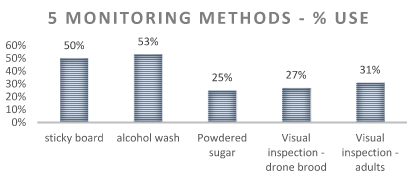
Whatever technique used, most sampling to monitor mites was done in July – September, as might be expected since mite numbers change most quickly during these months and sampling results can be used to key control decisions. Figure 16 illustrates monthly sampling with five methods.
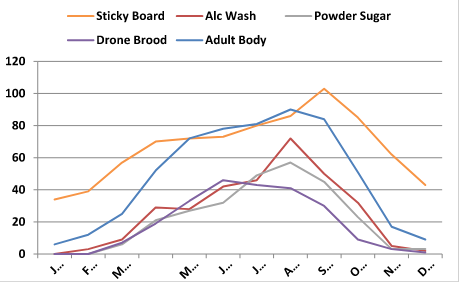
The most common sampling of respondents is both pre- and post-treatment (42% average). The sampling pre-treatment percentage has been decreasing while post treatment sampling has slowly been increasing. It is important to know if the treatment works so post treatment shouldn’t be avoided. Treatment without sampling was 13%, (last year it was 28% an anomaly, double the more typical percentage of this year).
It is important to KNOW mite numbers. Less effective mite monitoring methods include sticky (detritus) boards below the colony. Often so much detritus drops onto a sticky board that counting the mites can be hard, especially for new beekeepers). Sticky boards used for a single day pre- and post-treatment can help confirm the effectiveness of a treatment, if numbers drop post treatment. Visual sampling is not accurate: most mites are not on the adult bees, but in the brood, especially when there is a lot of brood and the adult mites are NOT on the adult body where they can be observed (over 90% are on the lower abdomen, tucked within the overlapping bee sternites). Sampling for mites on drone brood is also not effective as a predictive number but can be used as an early warning that mites are present; if done, look at what percentage of drone cells had mites.
See Tools for Varroa Monitoring Guide www.honeybeehealthcoalition.org/varroa on the Honey Bee Health Coalition website for a description of and to view videos demonstrating how best to do sugar shake or alcohol wash sampling. The Tools guide also includes suggested mite level to use to base control decisions based on the adult bee sampling. A colony is holding its own against mites if the mite sample is below 2%. It is critical to not allow mite levels to exceed 2-3% during the fall months when bees are rearing the fat fall bees that will overwinter. It is also the most challenging time to select a control method (if one is deemed needed) as potential treatment harm may negatively impact the colony. We are seeing more colonies suddenly disappear (abscond?) during the fall, which may be related to the treatment itself.
Mite Control Treatments
The survey asked about non-chemical mite treatments and also about use of chemicals for mite control. Thirty-one individuals (13%), four percent lower than last year, said they did not employ a non-chemical mite control and 29 individuals (12%), the same percentage as last year, did not use a chemical control. Those 41 individuals who did not use a non-chemical treatment reported a 30% winter loss, same as overall, while those who did not use a chemical control lost 48% of their colonies, 18 percentage point difference. The individual options chosen for non-chemical control are discussed below.

Non-Chemical Mite Control: Of nine non-chemical alternatives offered on the survey (+ other category) 51 individuals (28%) used one method, 68 used two, 45 used three, 26 used 4, 9 used 5 and 3 individuals used 6 plus one used or 7. Individuals using a single method had 35% loss rate, those using 2 had a 24.5% loss rate, those with 3 had a 25.5% loss, the 26 using 4 had 36% loss and the smaller number using 5 (44%), 6 (91%) and 7 had 100% loss. Clearly using more than one method/tool improves success
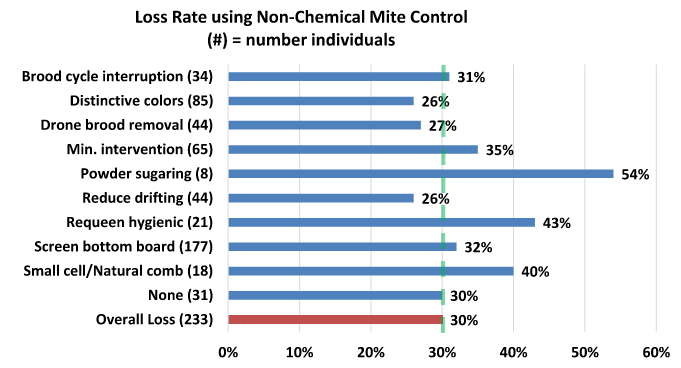
177 individuals (76% of total respondents) listed use of screened bottom boards. The next most common selection was distinctive colors (84 individuals). The use of the remaining selections is shown in Figure 19; number of individuals in ( ), bar length represents average loss level of those individuals using each method. Those left of the green dashed line had improved survival.
Three of the non-chemical alternatives have demonstrated reduced losses over the past 6 years. Reducing drifting such as spreading colonies (30% loss average for 5 years – question not asked in 2016-17 survey) and brood cycle break (33.9% average) have consistently year after year demonstrated somewhat better survival than average loss (35.6% average loss last 5 years and 37.5% loss last 6 years respectively). Different colony colors in apiary 36% average loss and drone brood removal (37% average loss) were just slightly better than average 6-year loss (38%).
Chemical Control: For mite chemical control, 29 individuals (12% of total respondents) used NO chemical treatment. They had a loss level of 48%. Those using chemicals used at a rate of 3.3 per individual. Thirty-eight individuals (17%) used one chemical (had 50% loss level), 42 used two and 3 (median number), 44 used 4, 18 used 5, 17 used 6 and 8 individuals used 7. Loss levels declined for those using 2, (loss 32%), 3 (loss 27%) and 4 (losses of 20%) but were higher for the 18 individuals indicating 6 chemicals used (38%) before falling for the 17 and 8 respectively who use 6 (24%) and 7 chemicals (loss 18%).
New to the survey this year we asked how many times a chemical was used in addition to which chemicals were used. For example, 55 individuals indicated they used the synthetic chemical Apivar (amitraz). The overall loss level was 28%. 42 used Apivar once and lost 27%; 12 used it twice, losing 37%. One individual used Apivar 3 times (label permits use twice per year) and lost 2 of 8 colonies overwinter – a 25% loss level.
There are two essential oil products on the market. Apiguard, the thymol gel was used by 64 individuals. They had a loss level of 20.5%. The 44 individuals that used it once had a 20% loss, the 12 using it twice had a loss of 24%, the 6 using it 3 times had a 19% loss level and the 2 individuals (6 colonies total, with one lost overwinter) had a 17% loss. ApiLifeVar, the wafer thymol product was used by 23 individuals – their overall loss was 22%. Those who used it once lost 17%, the 3 individuals using it twice had double the loss level of 33% while the 4 individuals that used ApiLifeVar 3 or 4 times had no loss of 13 overwintered colonies.
One hundred twenty-six respondents (62%) indicated they used oxalic acid vapor (OAV), 28 used oxalic acid dribble (OAD) and 14 used oxalic acid extended (OAE). Loss rates were 27% for OAV, 28% for OAD and 20.5% for OAE. For OAD, 22 used it once with 27% loss,, 5 individuals used it twice but had 31% loss and the single individual who used it 5 times had a 67% loss (lost 2 of 3 colonies). Overall loss for OAD was 28%.
For Oxalic acid extended (OAE) – the actual method used might have varied a great deal as everyone was experimenting on their bees as there is no approved product, or even application method, for OAE) – 18 individuals used it once with 25% loss, 8 said they used it twice (13.5% loss level), 5 indicated using it 3 times (19% loss) and one individual used it 5 times and lost 1 of 4 colonies overwinter (25% loss level).
For oxalic acid vaporization, I sorted the data differently. 26 individuals used it once and had 23% loss, 28 used it twice with 22.5% loss and 20 said they used it 3 times with 28% loss. This group using it one to 3 times, 84 individuals, had a 24% loss level. Additionally, 13 individuals said they used it 4 times with 30.5% loss and 10 individuals used it 5 times with 39.5% loss. Another group of 18 individuals used it 6+ times and had 31.5% loss. This group of 31 individuals, using oxalic 4 to 6+ times, had 33.5% loss. All oxalic acid users, a sum total of 125 individuals, had a loss level of 26.5 percent.
Not shown in Figure 20 were 4 individuals who indicated “other” with a total of 22 colonies – they had losses of 45.5%. At least one, with 6 colonies, lost 1/3rd, said they used thyme with mineral oil; one other mineral oil user with a single colony lost that colony. The 8 individuals using powdered sugar for mite control were included in the non-chemical data above. They had 26 colonies but lost 12 overwinter for 54% loss level. Finally, 2 individuals indicated they used fluvalinate – they lost all 6 of their colonies for 100% loss.
Consistently over the last 7 years, four different chemicals have helped beekeepers improve survival. These were essential oils Apiguard (average 7-year loss level 29.1%), Apivar (30.6% average 7-year loss level), ApiLifeVar (32.6% average loss level over last seven years) and Oxalic acid vaporization (30.7% average loss level over last 7 years. The average loss level has been 37.9% the last 7 years. Formic acid too has done better than average the last 7 years but the product has changed from MAGS to Formic Pro. This year the survey did not specify Formic Pro (listed was formic acid MAQS which no longer is on market), so I cannot be sure what Formic acid product was used by the 107 respondents who reported using it. Oxalic acid drizzle average of last 7 years is 36.2%, same as overall loss level of same time frame, 7 years The extended OAE (absorbing oxalic acid and glycerin into sponges) did very well in promoting better than average survival this year compared with last year when survival rate was only slightly better than average.
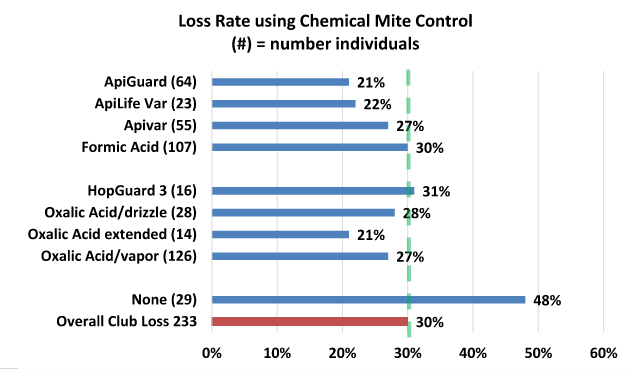
The monthly use of Apivar (blue line), essential oil (red line) or an acid (green line) is shown in Figure 21 for 2021-22 season. Further review is needed to determine if the timing of treatments was more effective than at other times for the various chemicals.
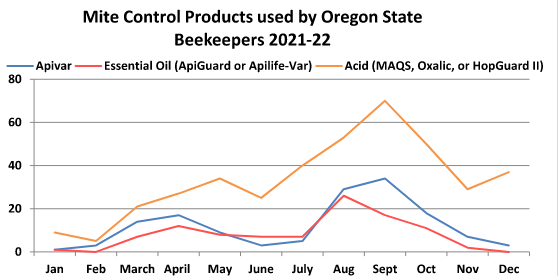
Antibiotic use
Three individuals (<1%) used Fumagillin (for Nosema control) and 2 individuals indicated use of terramycin. The 2 terramycin users had a 27% loss level lost 3 of 11 colonies) and those who used fumagillin had a 28.5% loss (lost 4 of 14 colonies). One nosevet user lost all 4 colonies overwinter.
Queens
We hear lots of issues related to queen “problems”. Queen events can be a significant factor contributing to a colony not performing as expected. We asked if you had marked queens in your hives. Eighty-five individuals (36.5%), same percentage as last year, said yes. The related question then was ‘were your hives requeened in any form?’ to which 58% (135 individuals) said yes and essentially equal numbers said no or not that they were aware of.
This survey is designed to ‘ground truth’ the larger, national Bee Informed loss survey. Some similar information is additionally available on the BeeInformed website www.beeinformed.org and individuals are encouraged to examine that data base as well. Recall that the BeeInformed survey is measuring the larger scale OR beekeepers not the backyarders (See American Bee Journal April 2020 article by Dewey). Reports for individual bee groups are customized and posted to the PNW website.
We intend to continue to refine this instrument each season and hope you will join in response next April. If you would like a reminder when the survey is open, please email us at [email protected] with “REMINDER” in the subject line. We have a blog on the pnwhoneybeesurvey.com and will respond to any questions or concerns you might have.
Thank You to all who participated. If you find any of this information of value, please consider adding your voice to the survey in a subsequent season.
Dewey Caron June 2023
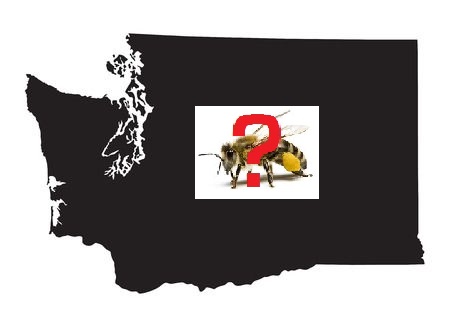
Winter Bee Losses of Washington Backyard Beekeepers for 2022-2023
by Dewey M. Caron
Click here to view a PDF of Washington report.
Overwintering losses of small-scale Washington backyard beekeepers=36%, an increase of a
single percentage point from last year, 11.2 percentage points below the 8-year loss average. One
hundred twenty Washington respondents completed a survey, 40 greater than last year. Information
on winter losses and several managements related to bee health was included on the electronic
honey bee survey instrument www.pnwhoneybeesurvey.com.
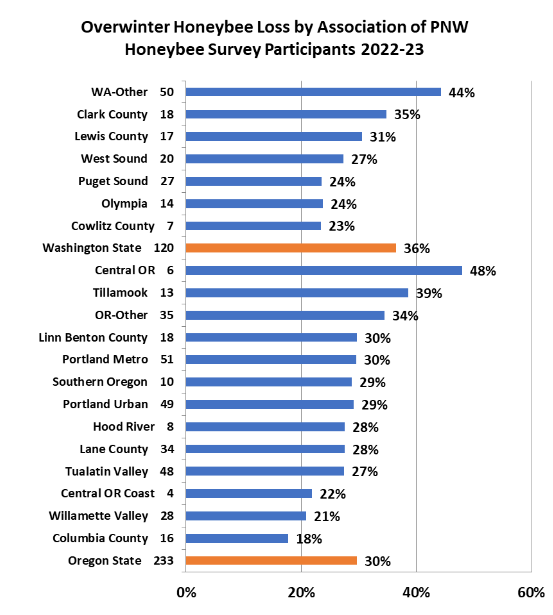
Response by local Oregon (OR) & Washington (WA) association varied as indicated by blue
bars in Figure 1. Statewide loss level is highlighted with orange bar. The number of respondent individuals is listed next to the association name. The bar length is the average club loss percentage
for the year. Survey included 692 fall Washington beekeeper colonies.
2022-2023 Overwinter Losses by Hive Type
2022-2023 Overwinter Losses by Hive Type
The Washington survey overwintering loss statistic was developed by subtracting number of
spring surviving colonies from fall colony number supplied by respondents by hive type. Results,
shown in Figure 2 bar graph, illustrate overwintering losses of 120 total WA beekeeper respondents
(677 fall colonies). Langstroth 8 and 10 frame beehives (90% of total) had lower average losses (35%)
than the 40 fall nuc (43% overwinter loss). Four of 6 top bar hives were lost but the single Warré hive
survived. Of the 16 total other hives only 5 were identified – as lng hives) – they had 40% loss level.
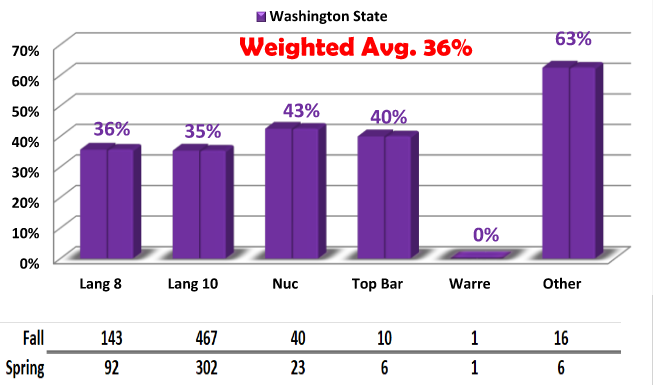
The WA respondents to the electronic survey managed up to 38 fall colonies. Fifteen individuals had a single colony (and had colony loss of 33%), 21 respondents had 2 colonies (the greatest number) with 51% loss and 20 individuals had 3 colonies (50% loss). Typical of the survey, fifty-six individuals (52.5% of respondents) had 1, 2 or 3 fall colonies (loss level of 49%). Thirty-one individuals had 4 to 6 fall colonies and had a loss level of 43%. Four was the median number. Thirteen individuals had 7 to 9 colonies, they had a loss level of 37.5%. Ten individuals had 10-19 colonies with loss level of 28%, 6 individuals with 20-38 colonies had loss level of 28% (but there was an outlier respondent who lost 23 colonies for 96% loss level – this group minus the outlier lost 21%. See Figure 3 (graph to left).
Forty-seven respondents (39% of total) had 1, 2 or 3 years of experience; they had a 34% loss level – individuals with 1-3 years experience had 50% loss. Thirty-eight individuals (31.7% of total respondents) had 4 – 6 years’ experience (medium number = 4) with a 35.5% loss, 15 individuals had 7-9 years experience (loss level 28%), 10 had 10-18 years keeping bees and 40% loss level (but minus the outlier, a loss level of 15.5%) and 7 had 20+ years experience (40 was maximum) and they had a 23% loss level. Figure 3 illustrates – arrows are colony loss; blue bars represent percent individuals. Examining the relationship of colony numbers and years experience related to loss shows that loss of colonies decreases with the greater the number of colonies and/or years of experience.
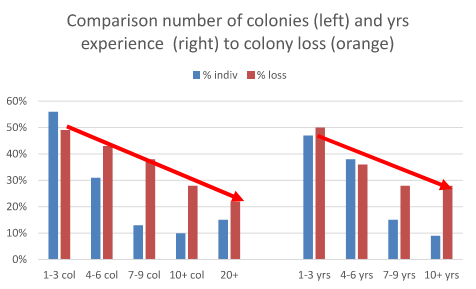
Eighty-six (72%) WA beekeepers had an experienced beekeeping mentor available as they were learning beekeeping. This percentage was 5 percentage points lower than last year, but similar to the 5 year average.
Survival Based on Hive Origination
We also asked about hive loss by origination. Data shown in Figure 4. Best survival was previously overwintered colonies and splits/divides. Package bee losses were over 50%. Both swarms and nucs had about the same survival per respondents. Figure 4 below.
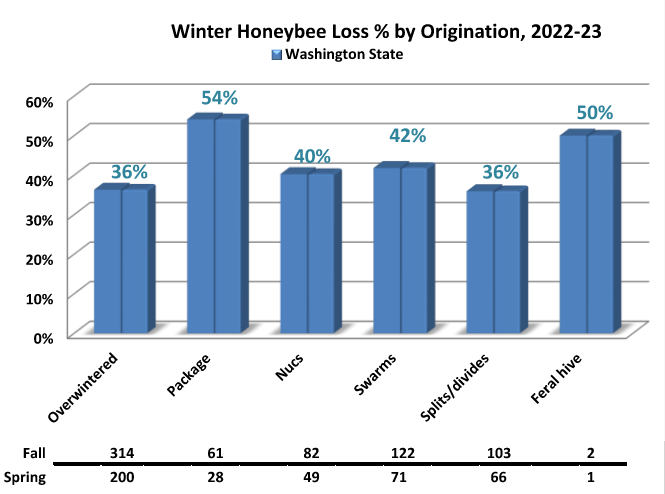
Among 120 WA beekeepers, 37 individuals (31%) had no loss and 30 individuals (25%) had total loss. Twenty-six individuals lost one colony, twenty-nine individuals lost 2 colonies (including 4 individuals with 10+ colonies) and 10 individuals lost 3 colonies (one with 10+ fall colonies). 69% of beekeepers losing colonies lost one to three colonies.
Comparison to Larger-Scale Beekeeper Losses
A different (paper) survey instrument was mailed to Pacific Northwest (PNW) semi-commercial (50-500 colonies) and commercial beekeepers (500+) asking about their overwintering losses. Comparison is shown in Figure 7 below with approximate number of colonies represented by the commercial/semi-commercial beekeepers and number of individual backyarder survey respondents.
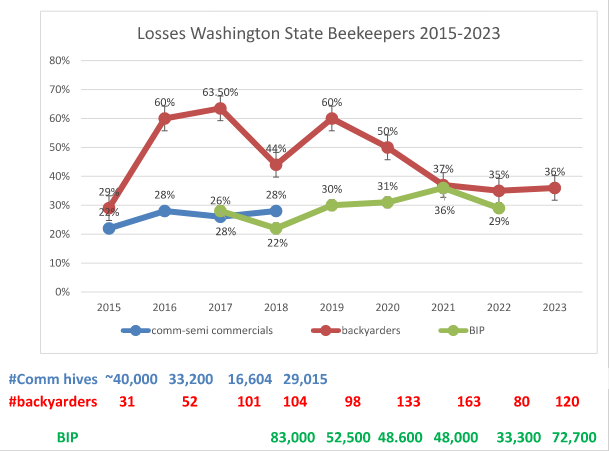
Backyard losses have consistently been higher, in some years double the losses of larger-scale beekeepers, but in 2018-19 the commercial losses were higher than backyarder losses. I think this is an artifact due to lack of a large commercial beekeeper response – The BeeInformed.org (BIP) losses for Washington beekeepers for 2019 were 30.13% from 133 beekeepers with 48,625 fall colonies. I believe the same issue (lack of representative responses) has provided unreliable commercial loss data for 2022 and 2023 from the PNW survey. The BIP survey results reveal a 35.14 loss percentage (83 beekeepers 33,307 col) in 2021 and 28.86% loss from 88 beekeepers with 72,684 fall colonies in 2022. With large numbers of colonies in survey data, the BIP losses reflect commercial losses not losses of backyarders.
The reasons backyarders have had higher losses 6 of the past 8 years are complex. Commercial and semi-commercial beekeepers examine colonies more frequently and they examine them first thing in the spring as they move virtually all of their colonies to pollinate almonds in February. They also are more likely to take losses in the fall and are more proactive in varroa mite control management.
The PNW survey was conducted in part to “ground truth” the annual BeeInformed Survey (BIP) also conducted during April. The BIP survey includes a mailed survey to larger-scale beekeepers and an electronic survey to which any Washington beekeeper can submit their data. Losses reported include colonies of migratory beekeepers who reported WA as one of their yearly locations. The BIP survey for the 2015-21 annual surveys reports receiving responses from 90 to 95% of respondents exclusive to Washington but loss is computed on no more than 4% of the colonies exclusive to Washington state, indicating the BIP tally is primarily of commercial beekeepers (who almost exclusively move to CA for pollination of almonds). With large numbers of colonies in survey data, the BIP losses reflect commercial losses not losses of backyarders average 7-year BIP WA loss is 26.7%. To access this data, see https://research.beeinformed.org/loss-map/
Apiary sites and moves
Ten survey respondents had bees at more than a single apiary. Half that number, 5 moved bees. One moved close for nucs, 1 moved 1000 miles, one moved to a new home and 2 moved for honey production.
Colony death perceived reason and acceptable loss level
We asked survey takers who had winter losses for the “reason” for their losses. More than one selection could be chosen. In all there were 156 WA selections (1.85/individual) provided. Weak in the fall (26 individual choices) and Varroa mites (44) were the most common choices. Cold and mice (2 selections each), absconding and mite treatment were the other reasons given. Figure 8 shows the number and percent of factor selections.
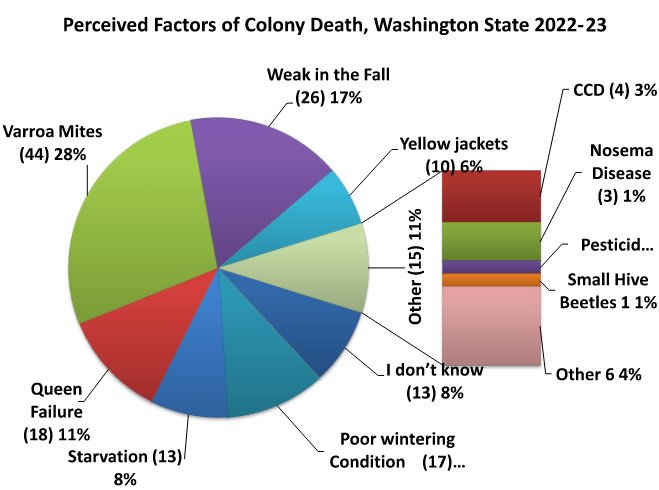
Acceptable loss: Survey respondents were asked the reason for loss. Nine (12%) indicated zero (no loss). Fifty-seven percent of individuals indicated 10% or less. 10% was a medium choice. Nineteen percent said 50% was an acceptable loss level. See table below.

Why do colonies die? There is no straightforward way to verify reason(s) for colony loss. Colonies in the same apiary may die for several reasons. There appears to be no single reason for loss and a good deal of variance in opinion as to what might be an acceptable loss level. We are dealing with living animals which are constantly exposed to many different challenges, both in the natural environment and the beekeeper’s apiary. Major factors are thought to be mites, pesticides, declining nutrition adequacy of the environment and diseases, especially viruses and Nosema. Management, failure to do something or doing things incorrectly, remains a factor in our losses. More attention to colony strength and checking stores to help avoid winter starvation will help reduce some of the losses. So, there is no simple answer to explain the levels of current losses nor is it possible to demonstrate that they are excessive for all the issues facing honey bees in the current environment.
Colony Managements
We asked in the survey for information about some managements practiced by respondents. The survey inquired about feeding practices, wintering preparations, sanitation measures utilized, screen bottom board usage, mite monitoring, both non-chemical and chemical mite control techniques and queens. Respondents could select multiple options and there was always a none and other selection possible. This analysis seeks to compare responses of this past season to previous survey years.
Most Washington beekeepers do not perform just one management to their colony (ies) toward improving colony health and overwintering success. This analysis compares a single factor equated with loss level. Such analysis is correlative and doing a similar management as fellow beekeepers does not necessarily mean you too will improve success.
FEEDING: Washington survey respondents checked 381 feeding options = 3.2/individual. One individual made no selections – they had one colony and lost it (100% loss). Thirteen respondents indicated a single choice and had 45% loss level. The best survival results were 3 or 4 selections. Table illustrates the relationship of number of selections to percent making selection (median was 3) and percent loss of those individuals.
The choices, with number of individuals making that selection, is in ( ), bar length indicates loss level of individuals doing this management (Figure 9). Those bar lengths to left of 36% (green dashed line) had better survival while those to right had greater loss level.
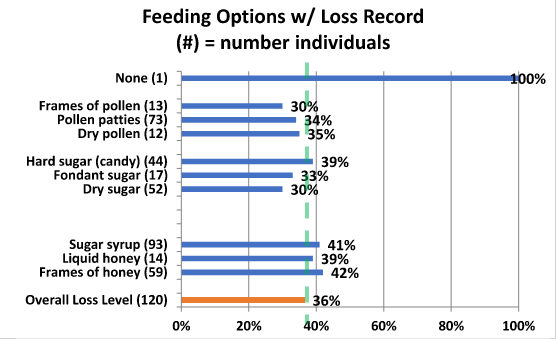
Feeding sugar syrup and pollen patties were the most common feeding option of respondents (93 and 73 individuals respectively). The loss rate of pollen patty feeders was 2 percentage points below state average. Best survival was feeding dry sugar (30%) and frames of pollen (also 30%).
For the last 6 years of survey losses statewide, individuals doing no feeding had poorer survival in 5 of the 6 years, this year one individual lost their single colonies. Individuals that fed sugar syrup had marginal lower loss level in four of six years (but not this year) as did those using frames of honey to feed bees. Individuals feeding non–liquid sugar in the form of hard candy likewise had lower losses in 4 of 6 years; this year 3 percentage point poorer survival. For individuals feeding protein, protein patty users showed slightly better survival in 4 of 6 years (including this year); dry pollen feeders had significantly better survival in four of the five years; this year only slightly better (a single percentage point difference) but number of individual respondents doing this management is not very large, this year 12 individual, 10%.
WINTERING PRACTICES: We received 330 responses (2.7/individual compared with 2.9/individual last year) reporting WA beekeeper wintering management practices (more than one option could be chosen). Six individuals (5%, same as last year) indicated none of the several listed wintering practices was done; these individuals had a single colony (of 14 total) survive winter, a 93% loss level. Last winter those doing no winter practices had an unusually favorable survival, 17% loss, while the year before it was a 74% winter loss.
For those indicating some management, 9 did one single thing and had 37% loss level. The best survival was those with 2 and 5 selections. Information presented in table to right. The managements selected that improved survival were wrapping/using colony insulation (30 individuals – 30% loss level), use of Vivaldi/moisture trap (87 individuals, 32% loss) and equalizing hive strength (25 individuals, also 32% loss level). Figure 10 shows the number of individual choices and percent of each selection. Bar length below 36% (blue dashed line) had better than average winter survival.
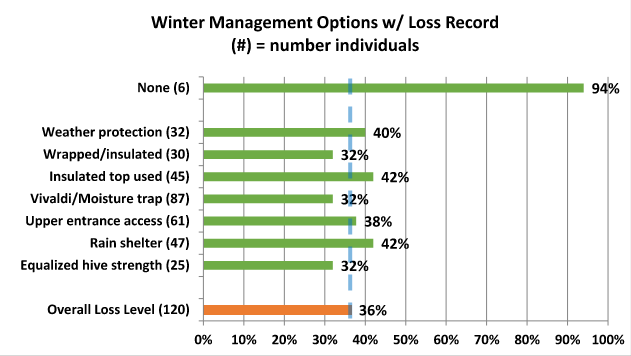
Over the past 6 years a couple of winterizing managements have shown improved survival. Those doing no winterizing had higher losses all 5 of 6 years (last winter was the exception). Equalizing hive strength in the fall demonstrated lower loss levels in all six recent winter periods (this year less than previous years) and top insulation has demonstrated lower loss in four of six winters but not this past winter; in the most recent winter 45 individuals had a 6 percentage point lower survival. Ventilation above the colony (Vivaldi Board/quilt box) demonstrated improved survival four of the six winters, this year a 2 percentage point better survival. The 3 individuals listing an other choice (closed upper entrance, added insulation or insulation tape at sides) lost only a single colony of six total.
SANITATION PRACTICES: It is critical that we practice some basic bee sanitation (some prefer use of term bee biosecurity) in our bee care to help insure healthy bees. We received 244 responses for this survey question 2.7/individual (last year it was 2.3/individual). Twenty-two individuals (24%) said they did not practice any of the 6 offered alternatives; they had a loss rate of 26%, 9 percentage point lower than the statewide average.
Twenty-two individuals had 1 selection and had 26% loss average, the best of the total. 34 made 2 choices with 35% loss, while the rest had considerably higher loss levels. It is clear than none of the measures is robust enough to make a difference by itself in reducing winter loss. Figure 11 shows the number of individual choices and percent of each selection. Bar length below 36% (green dashed line) had better than average winter survival.
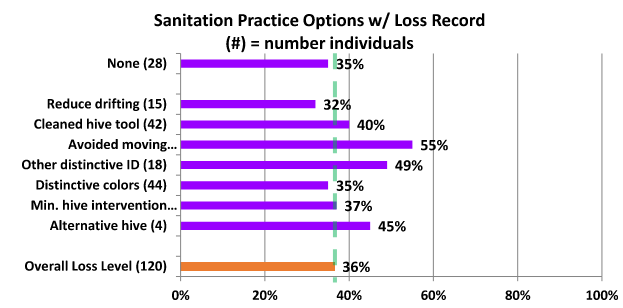
In all five years doing none of these managements resulted in better than average survival; this was the case this past winter when the 28 individuals doing nothing had average statewide losses. The 15 individuals reducing colony drift had a 32% loss level, 4 percentage points better than statewide. Providing hives with distinctive color/distinctive hive ID measures were helpful managements with losses just under 5 percentage points either side of average in all six years for statewide individuals.
SCREEN BOTTOM BOARDS (SBB)
Although many beekeepers use SBB to control varroa mites, BIP and PNW surveys clearly point out they are not or at best not a very effective varroa mite control tool. In this recent survey 19 Washington individuals (16%) said they did not use screen bottom boards; they lost 29% of their colonies. Those 24 beekeepers using SBB on some of their colonies lost 42% and the 77 individuals (64%) using SBB on all of their colonies had 36% loss.
In 7 survey years 20% of Washington beekeepers said they did not use SBB and 80% did use SBB on some or all of their colonies, see Figure 12.
Examining the seven year average of SBB use, those using SBB on all or some of their colonies had a 41.1% loss level whereas for those not using SBB the loss rate was 41.3% (a 0.2% positive survival gain for those using SBB versus those not using them). SBB are a very minor aid in improving overwinter survival for Washington beekeepers.
We asked if the SBB was left open (always response) or blocked during winter season. Sixty-three individuals (62%) said they always blocked SBB during winter. They had a 37.5% loss rate. Twenty-eight individuals (28%) said they never blocked SBB and had loss rate of 34.5%. Ten individuals (10%) blocked them on some of their colonies. Their loss rate was 54%.
There is no good science on whether open or closed bottoms make a difference overwinter, but some beekeepers “feel” bees do better with it closed overwinter. Comparing the always and sometimes left open (39% loss level) with the closed in winter response (37.5%) reveals a 1.5 percentage point difference in favor of closing the SBB over the winter period. This relationship has been consistent over the past five years averaging nearly an 8 percentage point advantage when the SBB is closed during the winter (although it was only a larger percentage point difference this last season. An open bottom, at least during the active brood rearing season, can assist the bees in keeping their hive cleaner and promote good hive ventilation.
Things that seem to improve winter success: It should be emphasized that these comparisons are correlations not causation. They are single comparisons of one item with loss numbers. Individual beekeepers do not do only one management option, nor do they necessarily do the same thing to all the colonies in their care. We do know moisture kills bees so we recommend hives be located in the sun out of the wind. If exposed, providing some extra wind/weather protection might improve survival. Early spring pollen is important so locations where bees have access to anything that may be flowering on sunny winter days is also good management.
Feeding, a common management, appears to be of some help in reducing losses. Feeding dry sugar or fondant during the winter meant lower loss levels. Providing honey or sugar syrup, the most common selection, did not mean lower winter loses but these basic managements are useful in other ways such as for spring development and/or development of new/weaker colonies besides insuring better winter survival.
Feeding protein in any form did slightly improve survival. The supplemental feeding of protein (pollen patties) might be of assistance earlier in the spring season has been demonstrated to help bees build strong colonies, but this may lead to greater swarming.
Winterizing measures that apparently helped lower losses for some beekeepers was equalizing strength, providing a moisture trap (Vivaldi board or quilt box) and some attention to adding protection against the elements. Spreading colonies out in the apiary and painting distinctive colors or doing other measures to reduce drifting also are of some value in reducing winter losses.
It is clear that doing nothing for feeding or winterizing resulted in the heaviest overwinter losses.
Replacing standard bottom boards for screened bottoms only marginally improved winter survival. It is apparently advantageous to close the bottom screens during winter.
Mite monitoring/sampling and control management
We asked percentage of Washington hives monitored for mites during the 2022 year and/or overwinter 2022-23, whether sampling was pre- or post-treatment or both and, of the 5 possible mite sampling methods, what method was used and when it was employed. Eighty-one individual respondents (67.5% – a decrease of 1.5 percentage points from last year) said they monitored all their hives. Losses of those individuals monitoring was 33%. Twenty-one (17.5%), reported no monitoring; they had a higher loss rate of 43%. Eighteen individuals monitored some with loss rate of 40%.
In order of popularity of use, 64 individuals used sticky boards, 64% total of 99 individuals who did some or all monitoring of colonies, looking on adults was indicated by 54 individuals (54%) who did some or all colony monitoring followed by 41 individuals (41% of individuals doing monitoring) that used alcohol wash. Forty individuals used drone brood monitoring and 17 used powder sugar to monitor In terms of losses, the sticky board users had 27.5% loss, alcohol washers had 36.5%, as did those looking a drone brood, worker inspection had 39% and powdered sugar users had the highest loss level at 49%.
Most sampling to monitor mites was done in July – September, as might be expected since mite numbers change most quickly during these months and results of sampling can most readily be used for control decisions. See Figure 13 below y illustrates by months when each of the 5 sampling methods were used.
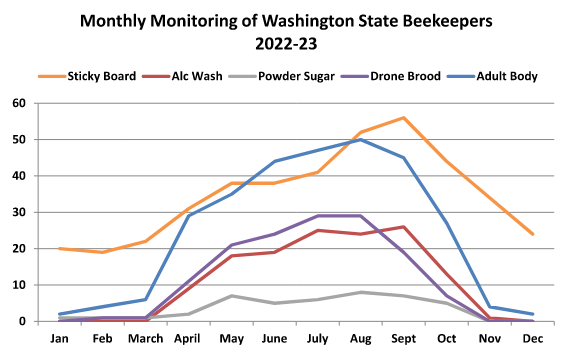
The most common sampling of respondents in 2021-22 was sampling both pre and post (45 individuals 38% of respondents); they had 37% loss, average for the 120 Washington beekeepers. Those 19 sampling pre had a 37.5% loss while those 6 sampling post had a 22% loss (this has been the lowest loss level selection each of last 2 years). Individuals neither sampling nor treating (21 individuals) had heaviest loss 43% while those treating but not sampling (28 individuals) had losses of (33%). The one individual that sampled but did not treat lost all 4 of their colonies.
It is important to KNOW mite numbers. Less effective mite monitoring methods include sticky (detritus) boards below the colony (often so much detritus drops onto a sticky board that picking out the mites can be hard, especially for new beekeepers) but sticky boards used for a day can help confirm the useful of a treatment when inserted post treatment. Visual sampling is not accurate: most mites are not on the adult bees, but in the brood. Unfortunately looking for mites on drone brood is also not effective as a predictive number but can be used as an early warning that mites are present; if done, look at what percentage of drone cells had mites.
See Tools for Varroa Monitoring Guide www.honeybeehealthcoalition.org/varroa on the Honey Bee Health Coalition website for a description of and to view videos demonstrating how best to do sugar shake or alcohol wash sampling. The Tools guide also includes suggested mite level to use to base control decisions based on the adult bee sampling. A colony is holding its own against mites if the mite sample is below 2%. It is critical to not allow mite levels to exceed 2% during the fall months when bees are rearing the fat fall bees that will overwinter. It is also the most difficult time to select a control method (if one is deemed needed) as potential treatment harm may negatively impact the colony. We are seeing more colonies suddenly disappear (abscond?) during the fall, which may be related to the treatment itself.
Mite Control Treatments
The survey asked about non-chemical mite treatments and also about use of chemicals for mite control. Ten individuals (8%) said they did not employ a non-chemical mite control and 3 individuals (2.5%) did not use a chemical control. Those 13 individuals who did not use a non-chemical treatment reported a 53% winter loss, while those who did not use a chemical control lost 50% of their colonies. The individual options chosen for non-chemical and chemical control are discussed below.
Non-Chemical Mite Control: Of nine non-chemical alternatives offered on the survey (+ other category,) 235 selections were indicated 2.1/person (last year 2.2/individual). Thirty-eight individuals used one method and had a 47% loss, thirty-eight used two (36.5% loss level), twenty used three (26% loss), ten used four (33% loss) and three used 5 and 1 indicated 6 choices, they had 14% loss.
Use of screened bottom board was listed by 89 individuals (81% of individuals selecting other than none). They had a 33.1% loss level. The best survival choices were requeening with hygienic stock (17%), small cell/natural comb (18.5% loss level and Drone brood removal (27% loss. The use of the remaining 7 selections are shown in Figure 14; number of individuals in ( ), bar length represents average loss level of those individuals using each method. Those to left of the green dashed line had better than average survival.
Two of the non-chemical alternatives – drone brood removal (29 individuals) and brood cycle interruptions (22 individuals)- have also been useful in previous year surveys in reducing winter losses(in some of past 6 years but not all) but brood removal this year did not improve survival. Painting hives with distinctive colors has resulted in better survival in each of the past four survey years but not this year. Small cell/natural comb has not been demonstrating better survival but did last year (but only by 3 percentage points) and this year for the 4 individuals (19% loss level).
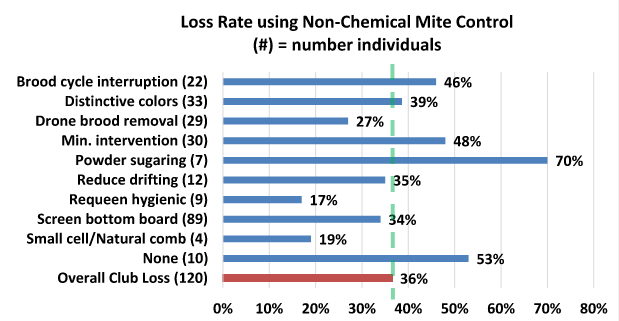
Chemical Control: For mite chemical control, 6 individuals (2.5% of total respondents) used NO chemical treatment; these individuals had a 50% loss level (those doing no treatments lost 67% last year). Those using chemicals used at rate of 1.9/individual. Forty-nine individuals (45%) used one chemical and had 35% loss, 39 used two and had 37% loss, 18 used 3 (38% loss), 6 used two and had 20% loss while the 2 using 5 had a 13% loss level.
Within those numbers there are some other patterns. For those using one chemical the use of oxalic by 26 individuals had a 26% loss, the 4 using formic had a 19% loss while 5 using Apivar had a 70.5% loss. Within the group using 2 choices (the medium) 10 used both Apivar and Oxalic vaporization and had a 42% loss, the 9 using Formic and OAV had a 26% loss and the 5 who used both ApiLifeVar and OAV had a 36% loss, the statewide average. For the 8 using 4 or 5 choices, all but one included oxalic acid – one who didn’t use oxalic had a 67% loss, those who did include it a 14% loss. It appears OAV or OAE (30 individuals, 25% of total chemical intervention users) used by itself or as a combination with formic gave the best overall results.
Figure 15 illustrates the number of uses ( ) and bar length indicates the loss rate for those using that chemical.
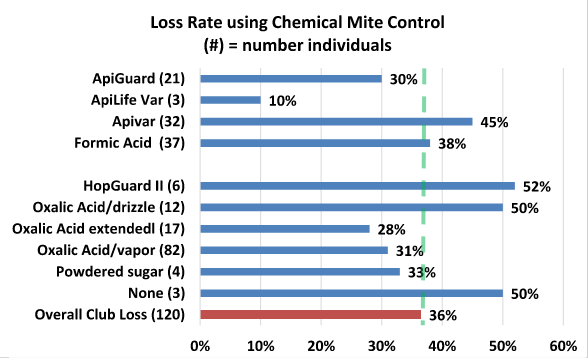
Consistently, the last 6 years five different chemicals have helped beekeepers realize better survival. The essential oils Apiguard and ApiLifeVar have consistently demonstrated the lowest loss level; this year 30% and 10% loss levels (last year no responding Washington beekeeper reported use of ApiLifeVar). Over the last six years Apiguard users had a 33.5% better survival rate. Apivar, the synthetic (amitraz), has demonstrated a 36% better survival over past 6 years (2017-22) but this year was 9 percentage points less survival compared to statewide.
Oxalic acid vaporization over past 5 years has a 17.5% better survival (the survey did not differentiate Oxalic vaporization from drizzle prior before 2018); this year just a 5 percentage point difference. Formic acid also normally provides better survival but this year did not, a 2 percentage point poorer survival.
The monthly use of Apivar (blue line), essential oil (red line) or an acid (green line) is shown in Figure 16 for last year. Further review is needed to determine if the timing of treatments was more effective than at other times for the various chemicals.
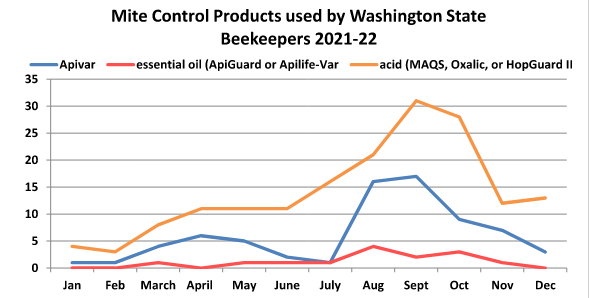
Four individuals used Terramycin and had a 23.5% loss level. One person indicated the use of both terramycin and tylosin and their 2 colonies both survived. Eight individuals indicated the use of Fumagillin (Fumidil-B) for Nosema control; their loss rate was 25.5%.
Queens
We hear lots of issues related to queen “problems.” Eleven individuals indicated queen problems as reason for loss in earlier part of survey. Queen events can be a significant factor contributing to a colony not performing as expected. We asked if you had marked queens in your hives. Forty-three individuals (36%) said yes. The related question then was ‘were your hives requeened in any form?’ to which 69% (83 individuals) said yes, 16 said no (12.5%) and the remainder ‘not that that I am aware of.’ Loss level of yes was 33% of the nos 29% and not aware of was 43.5%.
One technique to reduce mite buildup in a colony is to requeen/break the brood cycle. The question “How did bees/you requeen“ received 161 responses (more than one option could be checked). Thirty-nine individuals indicated they requeened with a mated queen and they had a 29% loss level, two used a virgin queen (18% loss) and 17 used a queen cell (29.5% loss). Twenty-eight said they split their hive(s) 31% loss, 43 indicated their colonies swarmed 35% loss and 32 said supersedure occurred – they had a 35% loss. Loss levels of colonies that did it themselves were not as favorable as those whose queen replacement was managed by the beekeeper.
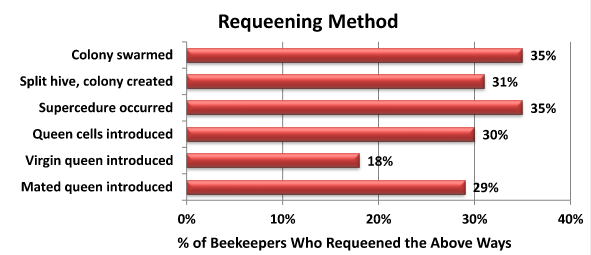
Closing comments
This survey is designed to ‘ground truth’ the larger, national Bee Informed loss survey. Some similar information is additionally available on the BeeInformed website www.beeinformed.org and individuals are encouraged to examine that data base as well. Recall that the BeeInformed survey is reporting losses of the larger scale WA beekeepers not the backyarders (Figure 5). Reports for individual bee groups with 18 or more respondents are customized and posted to the PNW website.
We intend to continue to refine this instrument each season and hope you will join in response next April. If you would like a reminder when survey is open please email us at [email protected] with “REMINDER” in the subject line. We have a blog on the pnwhoneybeesurvey.com and will respond to any questions or concerns you might have.
Thank You to all who participated. If you find any of this information of value, please consider adding your voice to the survey in a subsequent season.
Dewey Caron June 2023

